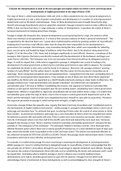Evaluate the interpretations in both of the two passages and explain which you think is more convincing about
developments in English government in the reign of Henry I [30]
The reign of Henry I, which lasted between 1100 and 1135, is often considered to be one of great developments in
English government as it was a time of greater centralisation and development of a number of central government
departments such as the bench and Exchequer. Many of these developments were brought about by the king
himself and passage B particularly seems to adopt this viewpoint. Passage A however seems to take a different view.
Whilst it does not deny that Henry I’s reign witnesses a variety of developments, it questions the extent of Henry’s
personal involvement in bringing about these changes.
Passage A adopts the viewpoint that, despite developments occurring during Henry’s reign, the extent to which
Henry was involved can be questioned as “it is hard to find concrete evidence of Henry’s personal involvement”. This
is supported by the idea that there was “a great deal of administrative activity by growing numbers of royal officials”,
implying that it was these royal officials rather than the king who were responsible for the developments in
government. For example, the Exchequer, a key innovation during this time, which was responsible for collecting
taxes, was set up by and headed by Roger of Salisbury rather than Henry. Due to his absence, being absent from
English 2/3 of the time after 1106, Henry had to delegate significantly to royal officials. However, a weakness of this
passage is that it ignores that Henry was directly involved with the development of the Exchequer and Roger was
under Henry’s direction. The Exchequer was in fact an innovation from Henry himself but he delegated control to
Roger. It could be argued that, unlike what is suggested in passage A, delegation was crucial in leading to the
development of central government as Henry had to centralise government to cope with his absence. For example,
he established the bench so that cases could be heard in his absence. Moreover, this passage mentions “growing
number of royal officials” but the author doesn’t consider that the reason for this was Henry’s innovative use of
patronage. Henry recognised competent men and appointed them, “raising them from the dust” and putting them in
control of the central government departments. A key example of one of these new men which Henry appointed
was Geoffrey de Clinton who was appointed as a sheriff despite previously owning no major lands. Furthermore, this
passage mentions how “royal administration was already centralised” and whilst there are examples of
centralisation prior 1100 such as William I establishing the treasury, this argument is limited as it provides little
evidence an also ignores how Henry expanded upon the pre-existing system, establishing more central government
departments. Whilst it is impossible to argue that centralisation did not exist before Henry’s reign, it is evident that
centralisation grew under the reign of Henry I due to the increase in central government departments such as the
bench and the Exchequer, both of which were established by Henry himself to cope with his absentness. Therefore,
the argument presented in passage A, whist having some strengths, is highly limited.
Conversely, passage B takes the opposite view, arguing that Henry had many innovations and “contributed much to
the development of English medieval instruments”. Unlike passage A, passage B acknowledges Henry’s clever use of
patronage and mentions how “he achieved that goal…by placing it firmly under the control of some twenty or thirty
loyal curiales”. As previously mentioned, patronage was a new innovation by Henry where he rewarded men whom
he believed to possess skill and loyalty with land. These curiales were more loyal than previously, which is evident
from his 1120 inquest where more than half of the sheriffs were fired and replaced by more loyal men. Moreover,
passage B also focuses on how “Henry’s machine worked to centralise and stabilise government” and gives the key
example of “the emergence of the exchequer”. The exchequer helped to develop a stricter, more thorough more
efficient financial system where there was a massive growth of bureaucracy as a more detailed account of taxes was
kept, which held sheriffs more accountable to the crown and royal control. This system was extremely effective as
tax collection increased by 50% from £20,000 to £30,000. Overall, this passage clearly demonstrates Henry’s various
innovations which led to more effective central government.
To conclude, it is evident that passage B is more convincing in assessing the development of central government.
Whilst passage A is correct in stating that Henry delegated heavily to royal officials, it fails to acknowledge that this
was actually one of Henry’s innovations through his use of patronage to appoint competent royal officials. Passage A
also ignores the variety of developments Henry did make such as establishing the bench and exchequer and it could
be argued that, contrasting what is stated in passage A, Henry’s absence was crucial in leading to these
developments as he had to centralise government to cope with his absence. Passage B on the other hand
acknowledges Henry’s involvement in these developments as well as acknowledging the clear strengths of Henry’s




